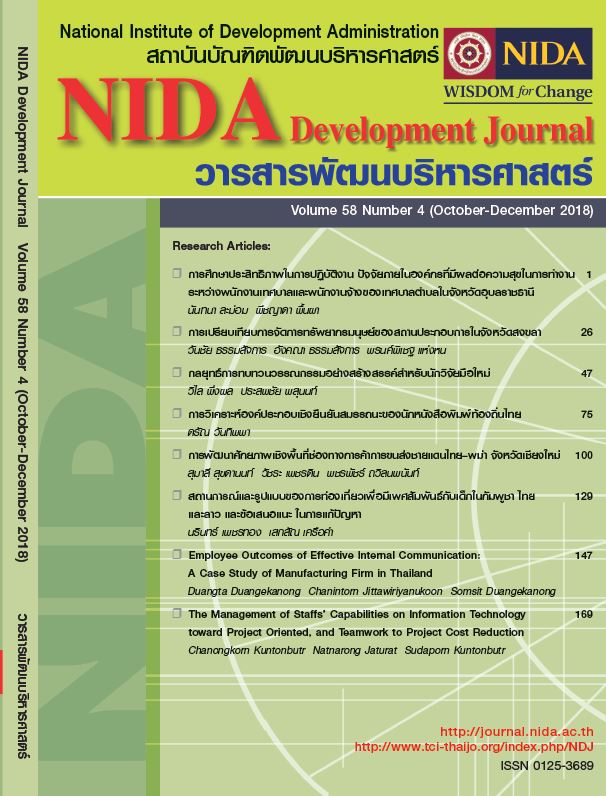Spatial Efficiency Enhancement of Thailand–Myanmar’s Cross–border Passes in Chiang Mai Province
Keywords:
Thai–Myanmarese cross-border trade, Borderland Potentiality, Chiang Mai province, Kiw Pha Wok pass, Lak Taeng passAbstract
This study aims to propose appropriate guideline for enhancement of potentiality of the communities located near Thai-Myanmarese checkpoints for border trade which are Kiw Pha Wok Temporary Border Checkpoint and Lak Taeng Temporary Border Checkpoint in Chiang Mai Province. The study take into account the in-depth interview, field survey, and related information and border trade statistics. The result shows that, due to different characteristic of each border checkpoint, they need different appropriate guidelines for development. Relevant rules, regulations, and development guidelines need to be reformed and suitably applied to each area, depending on the area’s characteristic. Government authorities, together with local authorities should join in this reform process. Moreover, there should be an establishment of the unit that is responsible for border economic issues and cooperate closely with Thai and Myanmar local authorities. These recommendations are expected to help develop efficiency of Thai-Myanmar border trade and enhance potentiality of the border communities in Chiang Mai Province.
References
ธนศักดิ์ เก่งถนอมม้า. (2541). ปัญหาและอุปสรรคในการดำเนินงานจุดผ่อนปรนทางการค้าชายแดนไทย–ปัญหาและอุปสรรคในการดำเนินงานจุดผ่อนปรนทางการค้าชายแดนไทย- พม่า ช่องกิ่วผาวอก อำเภอเชียงดาว จังหวัดเชียงใหม่ (วิทยานิพนธ์ปริญญามหาบัณฑิต). มหาวิทยาลัยเชียงใหม่, สำนักหอสมุด.
พรพิมล ตรีโชติ. (2551). การต่างประเทศพม่า: ปฏิสัมพันธ์กับเพื่อนบ้านและกลุ่มชาติพันธุ์ (Vol. 90). กรุงเทพมหานคร: สำนักพิมพ์จุฬาลงกรณ์มหาวิทยาลัย.
สิทธิพร ภูนริศ. (2552). โครงการพัฒนาคน ชุมชน และพื้นที่การค้าชายแดน จังหวัดแม่ฮ่องสอน: คณะนิติศาสตร์ มหาวิทยาลัยพายัพ.
สุมาลี สุขดานนท์. (2557). รายงานโครงการศึกษาเพื่อจัดทำฐานข้อมูลการค้าการขนส่งชายแดนไทย–พม่า. กรุงเทพมหานคร: สถาบันการขนส่ง จุฬาลงกรณ์มหาวิทยาลัย.
สุมาลี สุขดานนท์. (2558). รายงานการศึกษาประเมินศักยภาพช่องทางการค้าชายแดนไทย-พม่า. กรุงเทพมหานคร: สถาบันการขนส่ง จุฬาลงกรณ์มหาวิทยาลัย.
เอกสารอ้างอิงภาษาอังกฤษ
Dannecker, P., & Schaffar, W. (2016). The Thai-Burmese Borderland: Mobilities, Regimes,Actors and Changing Political Contexts. Asian Anthropology, 15(2), 132-151.
Democracy for Myanmar. (2009, September 10). Wa, the Ethnic Armed Group Has Expelled Outsiders, Who Do Not Have Entry and Residential Permits to Stay in Its Territories in Northeast Burma as of September 7 (Monday), Said Local Sources [Blog]. Retrieved from https://democracyforburma.wordpress.com/2009/09/10/wa-the-ethnic-armed-group-has- expelled-outsiders-who-do-not-have-entry-and-residential-permits-to-stay-in-its-territories-in- northeast-burma-as-of-september-7-monday-said-local-sources/
Ganesan, N. (2006). Thai-Myanmar-ASEAN Relations: The Politics of Face and Grace. Asian Affairs: An American Review, 33(3), 139-149.
Fullerton, T. (2003). Recent trends in border economics. Social Science Journal, 40(4), 583-592.
Han, E. (2017). Geopolitics, Ethnic Conflicts along the Border, and Chinese Foreign Policy Changes toward Myanmar. Asian Security, 13(1), 59-73.
Jones, L. (2014). The Political Economy of Myanmar’s Transition. Journal of Contemporary Asia, 44(1), 147-170.
Kiik, L. (2016). Nationalism and anti-ethno-politics: why ‘Chinese Development’ failed at Myanmar’s Myitsone Dam. Eurasian Geography and Economics, 57(3), 374-402.
Krainara, C., & Routray, J. K. (2015). Cross-Border Trades and Commerce between Thailand and Neighboring Countries: Policy Implications for Establishing Special Border Economic Zones. Journal of Borderlands Studies, 30(3), 345-363.
Kubo, K. (2017). Evolving Informal Remittance Methods among Myanmar Migrant Workers in Thailand. Journal of the Asia Pacific Economy, 22(3), 396-413.
Mahadevan, P. (2013). The Changing Politics and Geopolitics of Burma. Strategic Analysis, 37(5), 596-609.
Meehan, P. (2015). Fortifying or Fragmenting the State? The Political Economy of the Opium/Heroin Trade in Shan State, Myanmar, 1988–2013. Critical Asian Studies, 47(2), 253-282.
Payan, T. (2014). Theory-building in Border Studies: The View from North America. Eurasia Border Review, 5(1), 1-18.
Peck, F., & Mulvey, G. (2016). Cross-Border Collaboration in Economic Development: Institutional Change on the Anglo-Scottish Border. Journal of Borderlands Studies.
Trippl, M. (2010). Developing Cross-Border Regional Innovation Systems: Key Factors and Challenges. Tijdschrift voor Economische en Sociale Geografie, 101(2), 150-160.
Walther, O. (2012). Traders, Agricultural Entrepreneurs and The Development of Cross-Border Regions in West Africa. Entrepreneurship & Regional Development, 24(3-4), 123-141.
Translated Thai References
Chaisri C (Producer). (2012). The Marching Route of King Naresuan[Video]. Thailand.
Kengtanomma T. (1998). The problems and Obstructions of Thai-Myanmarese Border: Kiw Pha Wok Border Checkpoint, Chiangdao District, Chiangmai Province (Master’s Thesis). Chiangmai University, Central Library.
Phunarit S. (2009). The Project Development of Human, Community and Cross-Border Trade Area of Maehongson Province: Faculty of Law Payap University.
Sukdanont S. (2010). Development Project of information Database for Upper Great Mekong Sub-Region. Bangkok: Transportation Institute Chulalongkorn Inversity.
Sukdanont S. (2014). Development of Information Database for Thailand–Myanmar Cross–Border Trade and Transport. Bangkok: Transportation Institute Chulalongkorn Inversity.
Sukdanont S. (2015). The Assessment of the Potential of Passes along Thai–Myanmarese Border for Trade and Transport. Bangkok: Transportation Institute Chulalongkorn Inversity.
Trichot P. (1998). Myanmarese Foreign Affair: The interrelationship of Neigboring Country and Ethnic Groups (Vol 90). Bangkok: Chulalongkorn Press.





